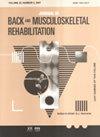The back body temperatures of patients with idiopathic scoliosis measured through exercise
IF 1.4
4区 医学
Q3 ORTHOPEDICS
引用次数: 0
Abstract
BACKGROUND: Aerobic exercise is closely associated with the vital functions of patients with scoliosis. Infrared thermography (IRT) has been increasingly applied in physiological measurements in recent years. OBJECTIVE: This observational study aimed to use IRT to examine the back body surface temperatures of patients with idiopathic scoliosis during aerobic exercise. METHODS: Forty-two participants who completed a pre-test were divided into a scoliotic group and a non-scoliotic group. Both groups completed a 30-minute cycling exercise, during which their back body temperature was measured using IRT, and the root-mean-square of the back electromyography value after 30 minutes of aerobic exercise was analyzed. RESULTS: The back body temperature decreased significantly after 30 minutes of exercise in the non-scoliotic group. In contrast, the back body temperature (at the trapezius and quadratus lumborum muscles) was asymmetric or increased after exercise in the scoliotic group. CONCLUSIONS: These findings suggest that when patients with scoliosis exercise, their back body temperature should be assessed thoroughly to prevent adverse physiological reactions potentially caused by back body temperature imbalances as well as the potential health problems caused by poor heat dissipation. In addition, such observations can be useful in the early screening of scoliosis.通过运动测量特发性脊柱侧弯症患者的背部体温
背景:有氧运动与脊柱侧弯症患者的生命功能密切相关。近年来,红外热成像(IRT)越来越多地应用于生理测量。目的:本观察性研究旨在使用 IRT 检测特发性脊柱侧弯症患者在有氧运动时的背部体表温度。方法:42 名完成预测试的参与者被分为脊柱侧弯症组和非脊柱侧弯症组。两组均完成了 30 分钟的自行车运动,在此期间使用 IRT 测量了他们的背部体温,并分析了有氧运动 30 分钟后背部肌电图值的均方根。结果:运动 30 分钟后,非脊柱侧弯组的背部体温明显下降。相反,脊柱侧弯组的背部体温(斜方肌和腰四头肌处)在运动后不对称或升高。结论:这些研究结果表明,脊柱侧弯症患者在进行锻炼时,应对其背部体温进行全面评估,以防止因背部体温失衡而可能引起的不良生理反应,以及因散热不良而可能导致的健康问题。此外,这些观察结果还有助于脊柱侧弯症的早期筛查。
本文章由计算机程序翻译,如有差异,请以英文原文为准。
求助全文
约1分钟内获得全文
求助全文
来源期刊
CiteScore
2.70
自引率
0.00%
发文量
194
审稿时长
6 months
期刊介绍:
The Journal of Back and Musculoskeletal Rehabilitation is a journal whose main focus is to present relevant information about the interdisciplinary approach to musculoskeletal rehabilitation for clinicians who treat patients with back and musculoskeletal pain complaints. It will provide readers with both 1) a general fund of knowledge on the assessment and management of specific problems and 2) new information considered to be state-of-the-art in the field. The intended audience is multidisciplinary as well as multi-specialty.
In each issue clinicians can find information which they can use in their patient setting the very next day.

 求助内容:
求助内容: 应助结果提醒方式:
应助结果提醒方式:


